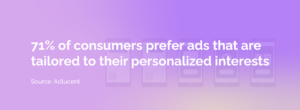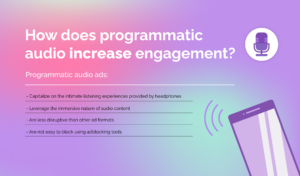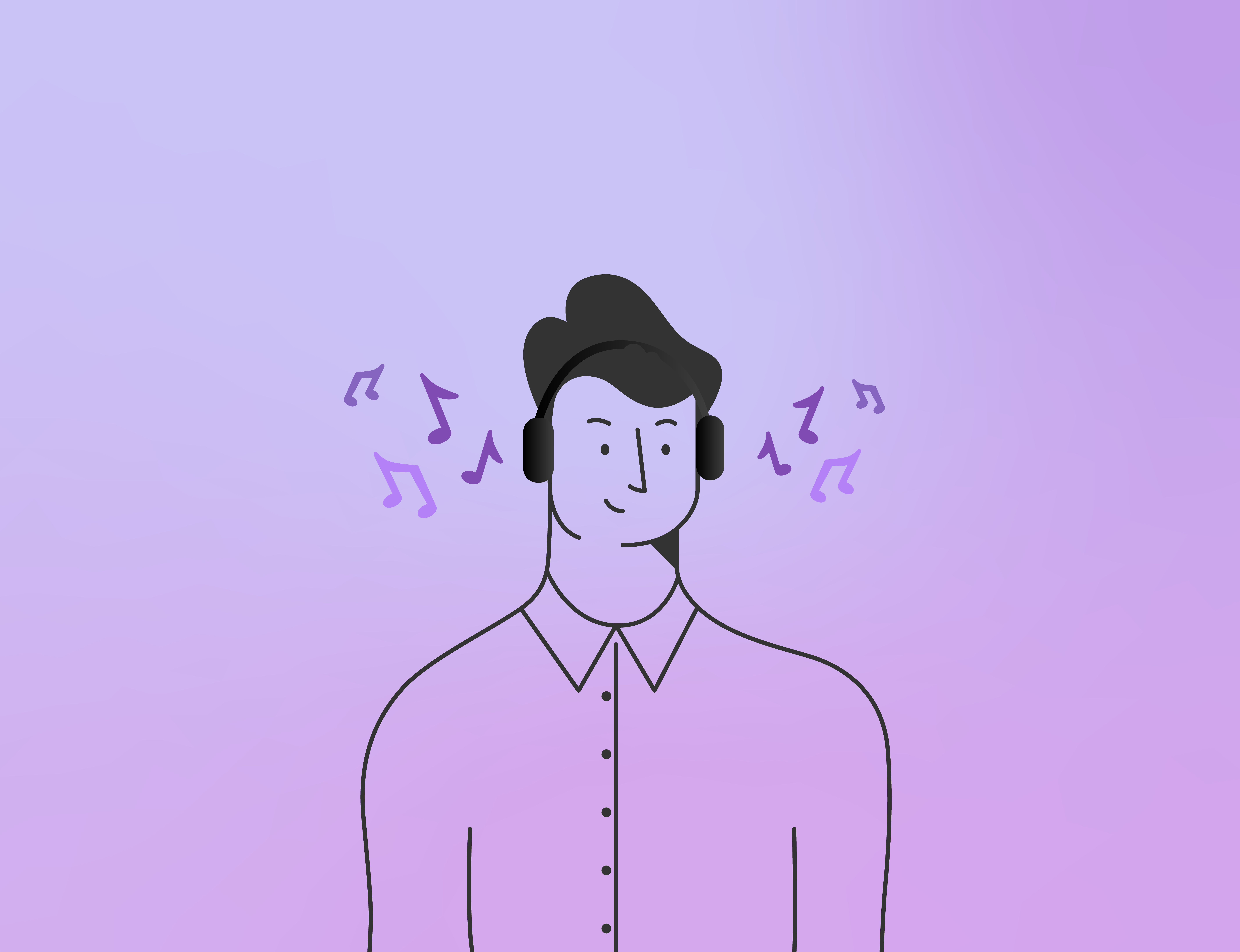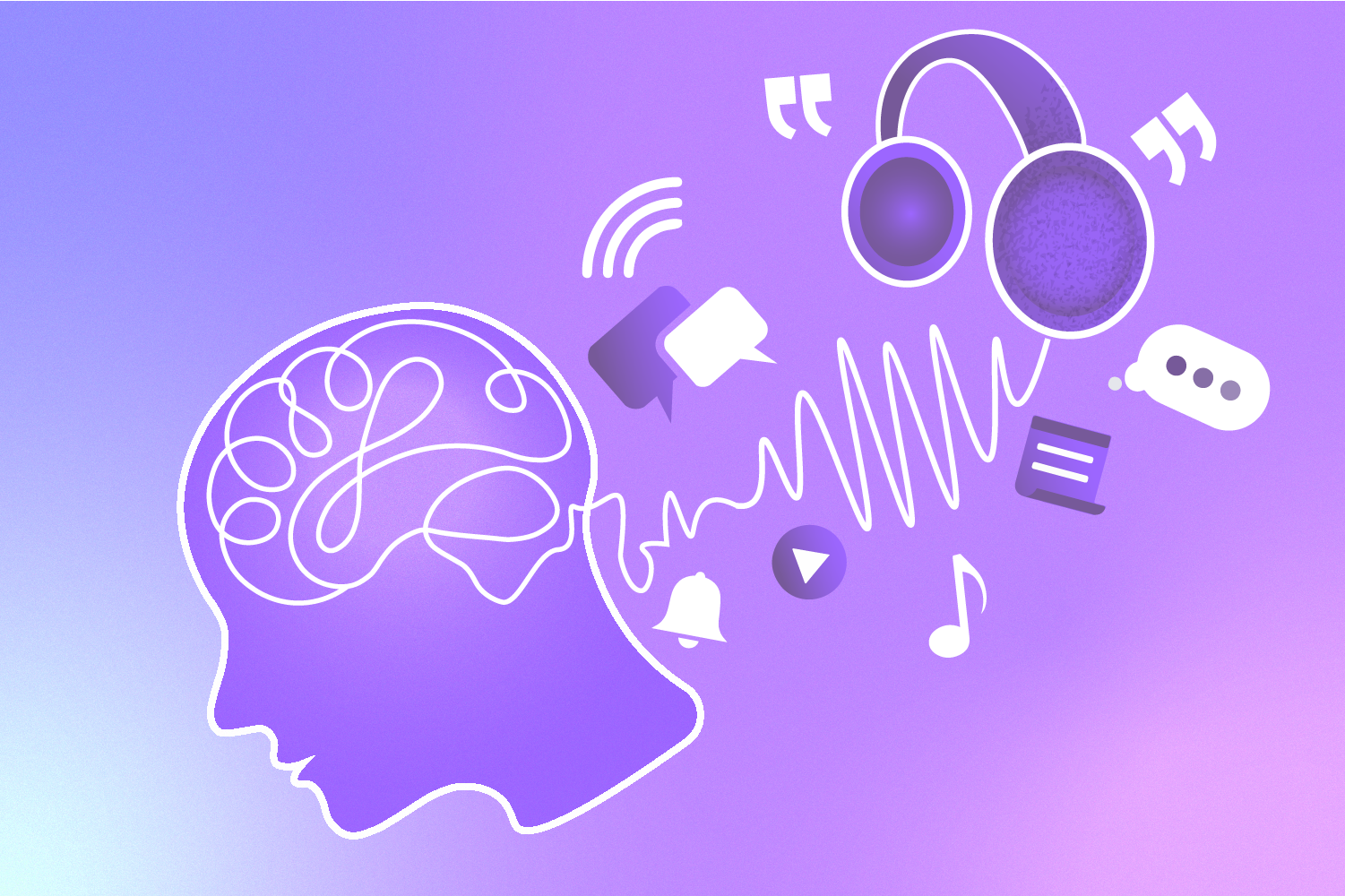In today’s connected world where a mobile device is always at hand, digital audio has become an integral part of our daily lives. Consider just how many podcasts, audiobooks, and music streaming services are available, plus the fact that 74% of US internet users listened to digital audio in 2022.
But while the diverse and dynamic digital audio landscape offers listeners a wealth of options, it also gives advertisers an excellent opportunity to reach and engage with their target audiences. This is where programmatic audio comes in.
Programmatic audio advertising is the use of automated processes to deliver audio ads to specific audiences. This includes inserting ads before or during news, podcasts, and music streaming.
Brands are eager to reach the right people at the right time, and programmatic audio advertising allows them to do just that. And if we go by the increasing ad spend, it’s clear that programmatic audio is a very effective advertising channel. A study by Acast has forecast that programmatic advertising spend in podcasts alone will triple by 2027.
Compared to other forms of advertising, programmatic audio offers several advantages that make it an attractive option for brands looking to expand their reach and drive conversions.

Targeting and Personalization
Programmatic audio advertising offers audience targeting options similar to those used in other advertising verticals, such as video, mobile, display, and cross-device campaigns. This means that advertisers can target campaigns based on demographics, geolocation, and device type, for instance.
That said, programmatic audio advertising also allows for more precise campaign targeting. You can, for example, use audio-specific data from audio partners to target specific demographics, playlists, niches, and genres that correspond to a campaign’s topic or mood.
For example, a car manufacturer may want to target young male audiophiles who listen to rock music and are interested in purchasing a sports car. An audio partner can provide data on the average age, gender, interests, and listening habits of users who frequently tune into rock music stations, which the advertiser can use to create targeted audio ads.
Similarly, an advertiser looking to reach a young hip-hop audience could use data to place ads during popular hip-hop playlists and podcasts. Moreover, the advertiser could use lyrics preference data to create ads that reference popular hip-hop themes and slang.
Given that 71% of consumers prefer personalized ads, this targeted and personalized approach increases the likelihood that the ad will be well-received and memorable, resulting in increased engagement and, most likely, conversions.

Programmatic audio advertising also enables premium digital audience targeting based on traditional broadcast parameters like geo, dayparting, and format, which can be measured against traditional radio KPIs like cost per point (CPP) and gross rating points (GRPs). In addition, advertisers can use programmatic audio to retarget people who have previously engaged with an audio ad, helping to move them further down the customer journey.
Efficiency
Digital audio is expected to account for 29.6% of all the time spent on mobile in 2023. Add in the growing number of mobile users, and advertisers have an even greater opportunity to reach consumers where they spend a significant amount of their time.
Programmatic audio also provides efficiency in several ways:
- Real-time bidding: Because programmatic audio advertising allows for real-time bidding, ads are delivered to the most valuable listeners at the right time. This results in more efficient use of the advertising budget when compared to other forms of advertising.
- Ease of creation: Audio ads are relatively simple to create. There are tens of thousands of talented voice-over (VO) artists who can transform copy into compelling audio ads in a matter of hours.
- Additional impact: With complimentary companion banners displaying on mobile devices when your audio ad runs, advertisers can enhance the effectiveness of their campaigns and maximize their impact.
Measurement and Data-Driven Decision-Making
Every advertiser wants detailed data on ad performance, and programmatic audio provides this, making it simple to track campaign effectiveness.
Advertisers can track audience behavior during and after an ad, including listen-through rates, completion rates, and post-listen conversions. This data can be used to make data-driven decisions and optimize ad campaigns for better results.
Engagement
Digital audio advertisements are appealing for a variety of reasons. For starters, there’s the issue of people listening to audio content through headphones. According to a Statista survey, 87% of people in the US use headphones to listen to music, while 36% use them to listen to the radio, and 28% to listen to audiobooks.
Because headphones create more intimate listening experiences, advertisers can use audio to command the listener’s attention. By the time the ad comes on, the advertiser can convey their message more effectively — the focused listeners will be more receptive, thus increasing engagement and the likelihood of conversions.
Secondly, audio content is hyper-engaging, with 70% of monthly podcast users doing nothing else while listening. The immersive nature of audio makes it easier for advertisers to increase campaign engagement. Even if listeners choose to do other things while they listen in, audio content is also convenient and non-disruptive — listeners can multitask while consuming the content.
Finally, programmatic audio advertising is less disruptive because it can limit the number of times an ad appears to the same listener over a given time frame, helping to keep ads fresh and relevant. This distinguishes it from other ad formats that may be more disruptive and less engaging. Aside from that, programmatic audio is also resistant to adblocking. Unlike with display ads, people can’t easily block audio ads, helping advertisers to get the most out of their ad spend.

Reach
The ultimate goal of advertising is to acquire customers and retain them. Increasing brand reach is an important part of this equation because it allows you to reach new customers.
Since audio ads can be placed on a variety of audio platforms, including music streaming services, podcasts, and radio stations, programmatic audio advertising allows brands to reach large and diverse audiences. And when it comes to music streaming services, audio advertising goes beyond Spotify. Programmatic audio ads can be placed on other platforms such as Pandora, Google Play, Idagio, and Soundcloud.
Furthermore, digital audio can reach audiences at almost any time and in almost any location, whether they are working, commuting, or exercising, for example. This allows brands to reach people where they are while still allowing them to go about their regular activities.
How Grapeseed Media Can Power your Programmatic Audio Mission
When done well, programmatic audio can be part of an advertising strategy that helps you generate positive ROI on ad spend and achieve your business goals.
At Grapeseed, we help brands leverage the unique benefits of programmatic audio advertising. The following are our digital audio targeting options:
- Dynamic retargeting: Retarget previous website traffic and cart abandoners with personalized audio spots that are based on their browsing history.
- Mobile footprinting: Retrieve and use mobile location data to provide targeted ads to users based on their historical or real-time location.
- App ownership personas: Identify your target audience by pre-qualifying users based on the apps they own and use.
- In-market audiences: Reach audiences based on their search and browsing history through our partnership with Google.
Considering the success that other forms of programmatic advertising have had in the world of advertising, there’s no doubt that programmatic audio is another game-changer that will allow brands to get the most out of their advertising campaigns. Moreover, programmatic audio has some distinct advantages that set it apart from other types of programmatic advertising.
The good news is that you don’t have to figure out programmatic audio advertising all on your own. Grapeseed’s team of experts can assist you. You can schedule a strategy chat with the team to learn more about how you can capitalize on programmatic audio advertising to connect with specific, targeted audiences and amplify your brand reach.





